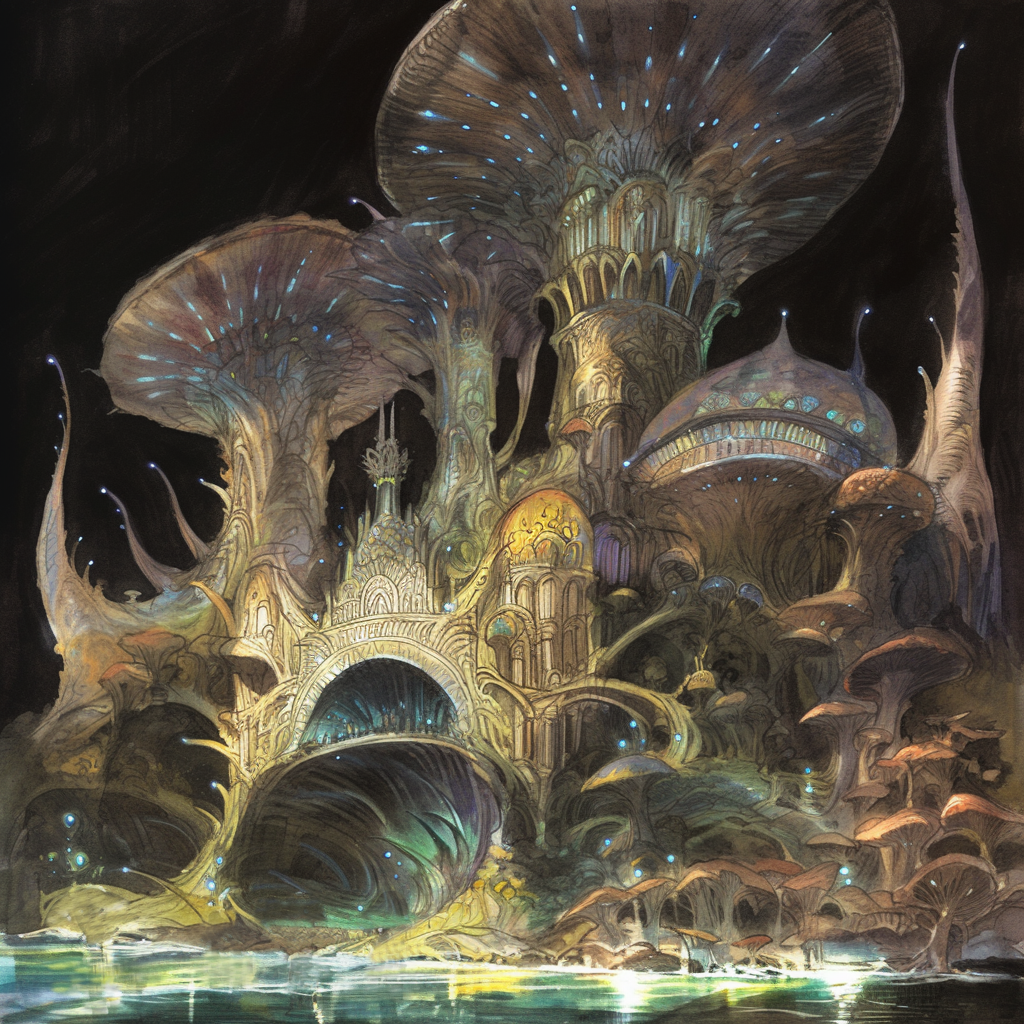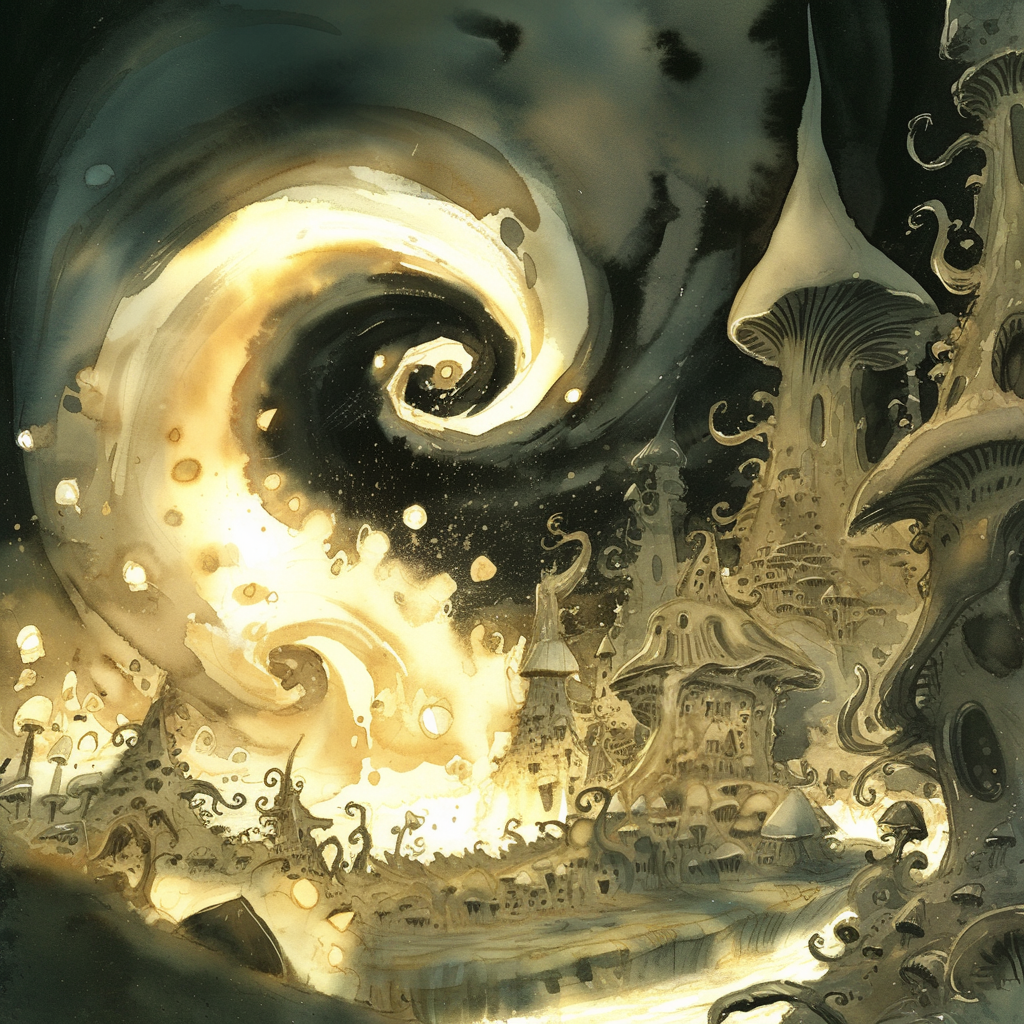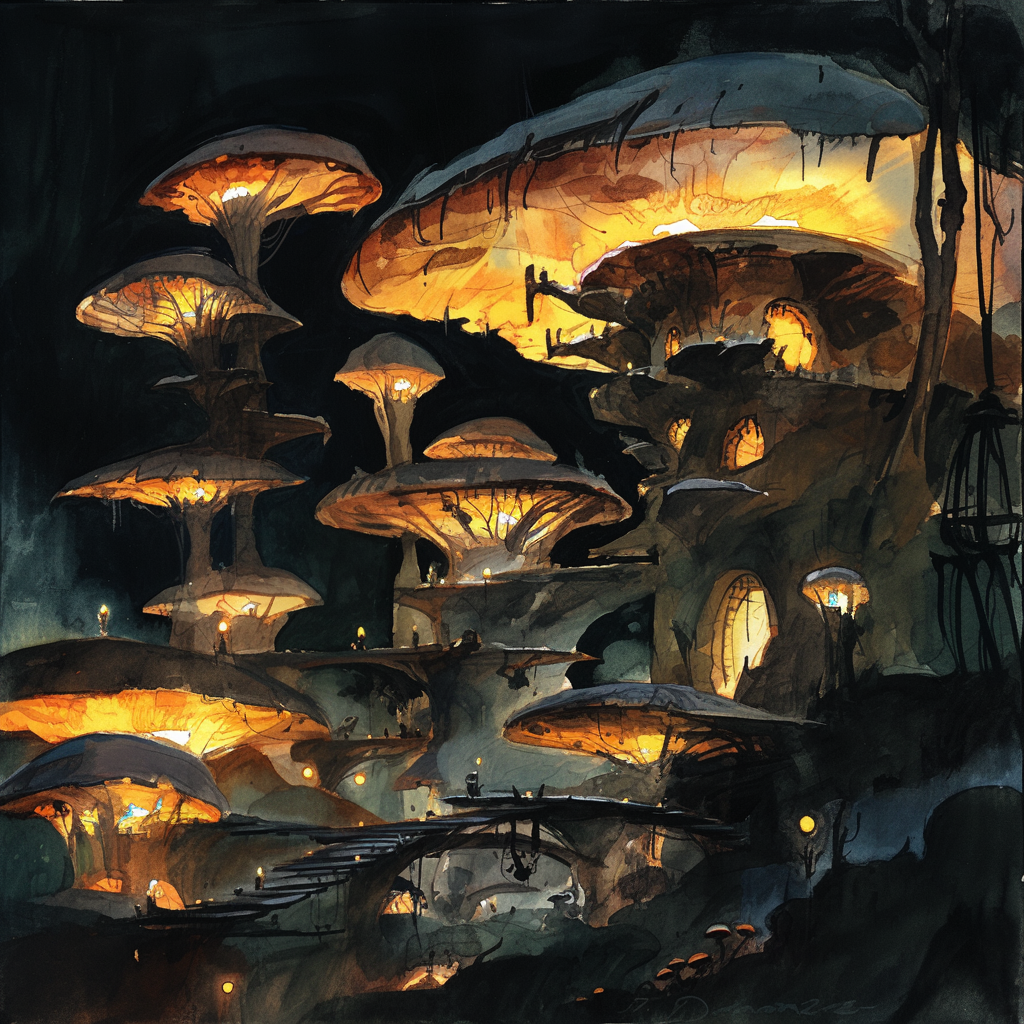Mycelia
Realm of Psilofyr

Location: Mechanus
Somewhere deep in the clockwork bowels of Mechanus lies Mycelia, a hidden realm of organic splendour nestled in the hollow of a massive, slowly turning gear. This is the sanctuary of Psilofyr, the power of thoughtful fungus and philosopher of interconnectedness; a tranquil place where the air is thick with psychic spores, the eternal cycle of decay and rebirth runs in an orderly pattern, and a psionic shroud ensures the realm is both secret and peaceful.
The first challenge for would-be visitors however is finding the elusive realm. Or rather, not finding it. Powerful psychic protections have been weaved by Psilofyr to ensure that the only way to find one’s way to Mycelia is not to be seeking it in the first place; and the only way to get closer to the realm is to move away from it. Such are the paradoxes of fungal philosophy, but this ward has served the realm well, in that is has never been attacked by an army and is rarely breached by hostile individuals.
Entering Mycelia feels like stepping into the underbelly of a sentient world—inside the cog there’s a vast, perfectly round space glowing with soft colours. Mushrooms of every size and shape carpet the ground, from delicate caps that sway like jellyfish to colossal spires that hum with psionic energy. Imagine descending a spongy spiral staircase inside the hollow cog, steps worn smooth by the shambling of countless feet and roots. The air grows warm and damp as you go, the metallic tang of Mechanus’ air being subsumed by the sweet, pungent scent of fertile decay. Emerging at the cavern’s edge, you’d behold a vast space one hundred miles across, its perfect roundness the only thing to remind you that you’re still in Mechanus.
The cave glows dimly under the soft bioluminescence of towering mushrooms in otherworldly hues of purple, azure, and pale green. Their caps spread wide like umbrellas, casting dappled shadows across the mulched floor, a blend of decomposed organic matter and fungal threads. Stalactites and stalagmites stand in deliberate patterns, as though arranged by a well-organised gardener, but aren’t made of rock—rather, they are soft fungal growths. The quiet down here is profound but not oppressive—you can hear soft dripping echoes from distant pools, and faint psychic murmurs flit like moths just at the edge of perception. A low sound, almost too deep for human ears, rumbles continuously as the fungal cavern-cog slowly rotates on its axis.
The air of Mycelia is filled with spores that enhance a cutter’s meditation and telepathy, allowing travellers to communicate without words and experience a heightened awareness of their place in the multiverse. However, those unprepared for such communion may become overwhelmed, losing themselves in visions of interconnected lives.
Visitors should tread carefully here, for the tiny fungi sprouting from the floor might be newly born myconids or petitioner spirits arriving in the realm. The sapient fungal folk wander in serene clusters, their steps nearly soundless on the damp mulch. To the uninitiated, their stillness and silence may seem unnerving, but those who pause and take a breath will feel comforted by the musky scent that the myconids exude.
The strange power of this realm, Psilofyr the Spore Lord, embodies a paradoxical fusion of decay and order. Fungi are nature’s recyclers, breaking down the old to nourish the new, and in Mycelia, this cycle is in perfect balance. Psilofyr teaches that harmony arises from the interconnectedness of all things—a mycelial network which binds life and death in cosmic unity. This divine philosophy places Psilofyr firmly within Mechanus’s fold, even as its methods may seem alien to the plane’s metallic sterility.
Psilofyr’s psionic powers manifest as a quiet dominance over thought and emotion. Violence, even the desire for it, is unthinkable within Mycelia. The god’s psychic web senses aggression like vibrations on a thread, and those who would be brutes find themselves teleported across Mechanus, often to a bewildering and inconvenient locale. Psilofyr does not banish out of cruelty, but to preserve the sanctity of the realm.
The Fruiting Palace of Psilofyr

At the centre of this fungal haven is the Fruiting Palace, a monolithic mushroom cluster rising from the surface of a black lake. The waters, unlike a mirror, reflect not the realm above but something far deeper—transient visions of other planes, distant myconid colonies, and strange and alien underdark realms, all of them connected to the unseen threads of Psilofyr’s tendrils. The lake’s depths somehow stretch far beyond the dimensions of the gear itself. The spongy walls of the palace pulsate gentley, as if the structure itself is breathing, and its cap glows with shifting colours. Few cutters ever approach the palace for its shores are guarded by an unseen force that turns away visitors, unless Psilofyr wills their presence. Psilofyr can also control the lake’s size, ensuring the unwelcome will face an endless voyage before reaching its far shore—while invited guests might find a simple bridge of toadstool stepping stones awaiting them.
Mythenosca
Near the centre of the cavern, not far from the Fruiting Palace, is the fungal-burg of Mythenosca. Here is where the greatest concentration of myconid dwellings can be found, as well as the spore market, the fungal farms, and the Circle of Nine, the high-ups of the realm. Learn more on Mythenosca here.
The Circle of Nine
Day-to-day governance of Mycelia falls to the Circle, nine myconid monarchs who embody the realm’s collective will. Petitioners must earn the Circle’s favour if they seek aid, wisdom or transcendence, and while their judgment can be ponderous, it is also final. Those who transgress the few laws of Mycelia face a grim punishment: suffocation by spores, their remains transformed into soil within minutes. Learn more about the Circle of Nine here.
What Mycelia Can Offer
While most residents of the realm are myconid or fungus leshy petitioners, meat-folk occasionally come seeking Mycelia’s famed fruits: healing poultices, hallucinogenic spores for exploring one’s consciousness or pacifying enemies, or magical inks distilled from rare mushrooms. Myconids, ever the courteous hosts, welcome all traders who approach with respect and reverence.
Many visitors speak of a deep psychic connection they feel within the realm—a sense of shared consciousness that lingers even after they leave. Psilofyr’s peace is contagious, they say, and the memory of Mycelia’s harmony haunts them like a dream they wish to return to, even though the realm itself may have hidden from them once more. For those who seek tranquillity or enlightenment, Mycelia offers both—if cutters are willing to accept its terms.
Rumours suggest that the modrons have attempted to study Mycelia, hoping to replicate its perfect recycling systems for Mechanus’s maintenance. Psilofyr, ever disdainful of meddling, has so far rebuffed these attempts with psionic subtlety—although stranded modron incursions might also explain some of the stranger residents of the Undergleam of Mythenosca.
The Sporestorms

Deep within the cavern of Mycelia, the ceaseless rotation of the massive gear creates a unique weather phenomenon: the sporestorm. These aren’t water-based atmospheric disturbances—they’re living, breathing tempest of fungal spores, imbued with psionic or divine energy. To an outsider, a sporestorm is a swirling chaotic haze of colour and motion, but to the myconids, it is a sacred and celebrated event, as vital to the ecosystem as rain to a forest.
A sporestorm begins as faint ripples in the musky air, which slowly gather momentum, drawing spores from every corner of the cavern into a spiralling vortex of light and shadow. The great mushroom-towers of Mycelia sway in the currents, releasing their own spores in synchrony with the storm’s rising power. The cavern fills with a soft, humming resonance, a sound that grows louder as the storm peaks. The light from bioluminescent fungi refracts through the spore clouds, painting the storm in flickering shades of violet, green, and gold.
A sporestorm is quite the sensory overload. The air shimmers with cascading light patterns, as spores refract and amplify the dim glow of the cavern. The scent of damp earth, sweet decay, and medicinal sharpness intensifies, almost as if the cavern itself is breathing deeply. The spores cling to the skin, soft and cool, while currents of psionic energy prickle like static against the mind. But they’re not just a dazzling spectacle—a sporestorm can have profound, and sometimes unsettling, effects on those exposed to it.
| Sporestorm Effects [roll 1d4] |
| 1. Memory Distortion: The spores in the storm resonate with the mind, dredging up memories and thoughts as if they were physical objects. Wanderers have reported vividly reliving forgotten moments from their past, even those they had though lost, only to discover the memories altered in strange ways after the storm subsides. A joyful memory might gain a sinister edge, while painful memories may be soothed. |
| 2. Psionic Hallucinations: The psionic charge of the storm is a boon to those attuned to mental powers. Telepathic communication becomes effortless, and those with latent psionic abilities may find them awakened, sometimes explosively. Myconids use these storms as communal rituals, linking minds across vast distances in a unified thoughtstream. Outsiders, however, may find their own thoughts exposed, and vulnerable to the collective scrutiny of the fungal network. Such sporestorms can also induce vivid hallucinations, and not all are benign. Some travellers report visions of endless fungal forests, glowing with impossible colours. Others see nightmarish landscapes, twisted by the alien logic of the myconid gestalt. The visions are deeply personal, often revealing hidden fears or desires. |
| 3. Fungal Growth: The spores in these kinds of storm carry a potent seed of life within them. Prolonged exposure can cause fungal growth on clothing, equipment, and even the skin. These are usually harmless and fade after the storm passes—unless, of course, one has angered the Circle or wandered too close to the Undergleam. In such cases, the growth may become parasitic, creeping into the mind and body. Meat-folk beware! |
| 4. Time Disorientation: Time flows strangely within the storm. Hours can stretch into days, or days may pass in the blink of an eye. Those unfamiliar with Mycelia’s rhythms often emerge disoriented, unsure how long they’ve been within the cavern. The myconids, naturally, view time as cyclical, and seem unaffected by such disruptions. |
To the myconids, sporestorms are both sacred and practical. They use the opportunities afforded by the storm to disperse their essence across the realm, ensuring the fungal ecosystem remains vibrant and interconnected. Farmers use the nutrient-rich spores to enhance their crops, while artisans collect rare strains of bioluminescent spores for their creations. Traders even bottle the storm’s spores, selling them as potent reagents or hallucinatory experiences to outsiders. Religious rituals are often performed during the storms, and it’s times like this that the Circle of Nine commune directly with Psilofyr’s divine will through the psionic winds.
Though beautiful, sporestorms are not without danger, especially for the unprepared. Masks and protective charms are vital for visitors to avoid inhaling a lungful of spores. Those who fail to protect themselves may experience a condition where the spores take root within the mind or body. Victims of Sporebound Syndrome become permanently psychically connected to Mycelia, hearing the constant whispers of the fungal gestalt even after they leave the realm. Even worse is Mushrooming, a rare but often fatal condition which causes fungal growths to erupt from the victim’s body, eventually consuming them entirely. These victims quickly become part of Mycelia’s mulch.
Canonical Sources: On Hallowed Ground [2e] p176; Planes of Law [2e] Mechanus p10-11,20-21. Canonwatch: Sporestorms are a homebrew addition to the realm.
Source: Jon Winter-Holt


